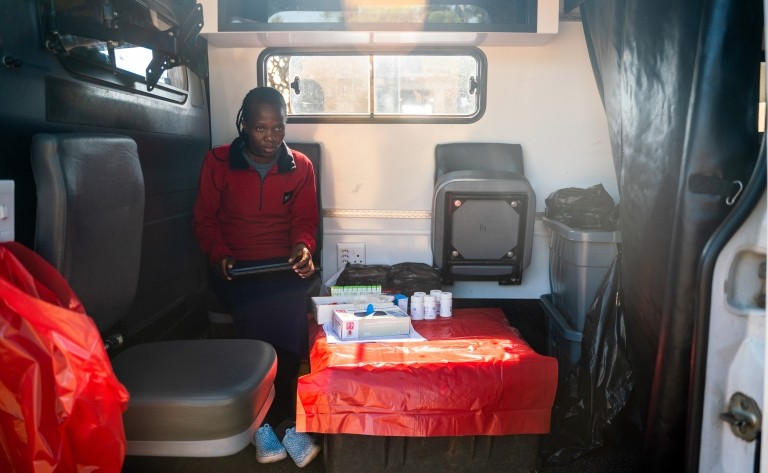Blog
To improve care access and quality, focus on integrated health service delivery

At Pact, we work closely with communities to meet their needs, including the fundamental right to health. In our experience, communities frequently desire integrated services or a “one-stop shopping” model within collaboratively developed solutions for better health care access and quality.
For example, in 2021, Pact launched the Community Action for HIV Control project in Ukraine. Funded by USAID, the project is working to accelerate Ukraine’s efforts toward HIV epidemic control through improved prevention, testing and care among key populations. HIV, of course, is the program’s main focus. Yet the communities we serve prioritized other care, particularly integration of HIV and chronic illness and mental health care and identifying safe routes to health care provision, to meet their needs after the war with Russia started. In response, we are supporting our local partners to provide highly accessible care for diabetes, hypertension, mental health disorders, gender-based violence and more, in addition to HIV and hepatitis testing and treatment. Services are offered by mobile health teams in Kyiv, Zhytomyr and Chernihiv, which screen and treat clients for a range of concerns.

Since establishing the mobile health teams, we have seen great demand for their services, and we are confident that they will make a difference in Ukraine’s fight against HIV.
Their success so far speaks to the power of integrated health care delivery, which Pact is progressively incorporating across our global health programming. Essentially, integrated health delivery reflects an attitude that all of a patient’s care can and should be facilitated by one provider in a single visit. Under non-integrated models, clients go to multiple places to receive services, such as HIV testing and prevention or treatment, and then primary care, and then mental health care. With integrated health delivery, patients receive a range of services in one place at one time.
While some of the benefits of such delivery are obvious, at Pact, our vision when it comes to integrated health care delivery is that it must provide a substantial value addition, especially when it comes to increasing access and improving the quality of care at a system level. We have examples of this from both health system strengthening and from community engagement perspectives.
Key constraints of health systems, such as limited human resources, may be lessened by integrating services. Integrating services permits a focused visit with a single provider, streamlining the care experience and potentially fostering efficiency and reducing crowding and daily client volume burdens. Having one entry point for care also allows for streamlining of clinical data entry and use, potentially strengthening health data management.
USAID Zambia Integrated Health is a strong example. The project has engaged district health offices through HIV and maternal and child health coordinators to identify gaps in facility-level performance, as well as activities to address them. This includes finding efficiencies to reduce strain on the limited number of providers. USAID Zambia Integrated Health supports and monitors these activities, which have developed integrated care packages and other service delivery efficiencies, through funding and technical assistance for implementation. Involving district health officers in activity design and planning has also afforded opportunities for including other services, such as mental health care and screenings and services for diabetes, hypertension and cervical cancer.
Integrated health delivery can also be an entry point for improving service quality. Integrated care tends to strengthen engagements with more people in a given community, thereby reinforcing relationships between communities and health care providers and facilities. With integrated service delivery, one provider is able to establish a relationship with a wider range of clients and actively seek feedback to ensure all needs are met. This approach also empowers community members to ask for services and advice on health maintenance and disease prevention, such as discussing HIV pre-exposure prophylaxis while receiving family planning services.
Our work in Ukraine is already beginning to demonstrate this, and in Nigeria, under the Bill & Melinda Gates Foundation-funded State Accountability for Quality Improvement Project (SAQIP), we saw this, too. Pact implemented SAQIP in Gombe State, strengthening the capacity of the State Primary Health Care Development Agency and its local structures to provide quality maternal, neonatal and child health services through public primary health centers. Working with structures such as Ward Development Committees, SAQIP improved delivery of quality services – including through health facility and laboratory renovation, improving access to electricity via solar power and generators, and acquiring ambulances. SAQIP supported health centers with quality improvement interventions, improving their capacity to engage communities. The project trained primary health staff on maternal and newborn health and postpartum family planning, leading to the integration of best practices.
The results included substantial increases in antenatal care visits among pregnant women, skilled delivery attendance at facilities, health workers correctly managing hypertensive disorders of pregnancy, and newborns receiving immediate skin-to-skin contact within a two-year period.
Integration beyond the realm of health is important, too. Pact integrates health into other sectoral services, such as bringing health care services into schools and combining health services with environmental or climate awareness programming. In Madagascar, for example, malnutrition is exacerbated by drought and climate change, so it only makes sense to link health and environment programs. In Zimbabwe, we are integrating climate resilience awareness and activities within health care for children living with HIV and their families.
As a global community, if we are going to achieve health access for all, we must use all available strategies. Certainly, integrated service delivery is a critical one, and it relies on action at the community, facility and health systems levels.